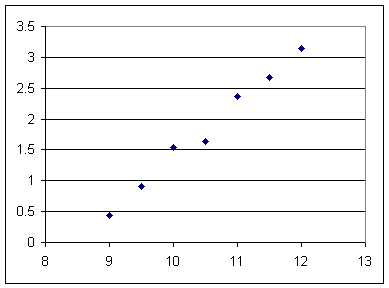
0927
change default page on each computer to http://vhmthphy.vhcc.edu
For reference: Synopsis with References to Multiple Choice
Path from Default Page: Precalculus I > Assts scroll to bottom of page then Partial Notes for Fall 2004
Note for reference: Linked Outline
At the computer, use Windows Explorer to find h:\shares\physics and open the program Multiple Choice Questions. Using 163 as your course, run the following, in order, getting as far as you can.
In addition to completing the worksheets distributed Friday do the following exercise, which will be the content of Wednesday's class:
The graph below consists of a number of observations of the amount of weight in Newtons suspended from a rubber band vs. the length in cm of the rubber band. We can assume that there is some uncertainty in every observation, due either to user carelessness or to gremlins.
Substitute the coordinates of your two points into the generalized form y = m x + b of a linear function.
Do you think that the straight-line model is probably pretty accurate for this rubber band, in the sense that the actual weights supported at 9, 9.5, 10, 10.5, 11, 11.5 and 12 cm are probably closer to the values predicted by the straight line than to values predicted by the actual data points on the graph?
Is there any evidence that the behavior of the rubber band is not really linear?

The graph below depicts similar data for another rubber band. Sketch your best-fit straight line.
Assume that there is some experimental error in these observations, but not nearly as much as in the previous graph. Does it appear that the actual behavior of this rubber band deviates in a significant manner from linear?
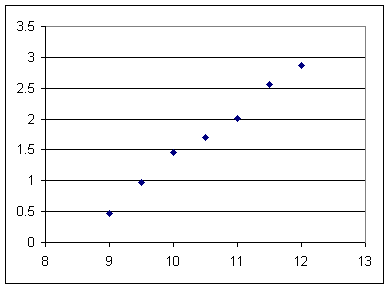
The graph below depicts another set of data for the same rubber band observed in the preceding graph.
Is there significant evidence that the behavior of this rubber band deviates at least slightly from linear?
Sketch your 'best' straight-line model for the data in the preceding, then compare its slope with that of the model shown below by stating which has the greater slope, and by supporting your claim.
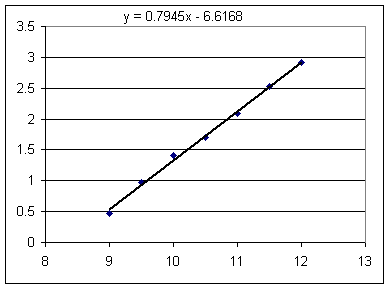
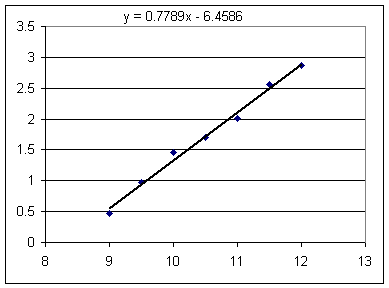
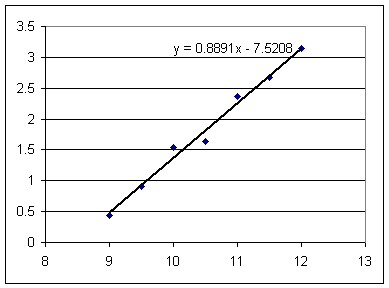
The basic linear function
is y = x.
Typical situations involving
linear functions include
We can form a good linear model of a set of
data points by sketching a line which minimizes the average distance between the data
points and the line.
Given two points on a straight line we can
use the slope = slope form ( y - y1) / ( x - x1) = slope, where slope = rise / run = ( y2
- y1) / ( x2 - x1).
The basic points on the graph of a linear function are taken to be the y-intercept and the point 1 unit to the right and m units up from this point.
For any function y = y(x), between x = x1 and x = x2 the linear function between the two corresponding graph points gives us an approximation of the original function.
An equation of the form a(n+1) = a(n) + m, with an initial value a(0), generates a set of points which lie on the graph of a straight line whose slope is m and whose y intercept is a(0).
Problem Number 1
Problem: Obtain a quadratic depth vs. clock time model if depths of 67.39103 cm, 52.27462 cm and 42.65076 cm are observed at clock times t = 9.731353, 19.46271 and 29.19406 seconds.
This means to plug the numbers into the form of a quadratic and solve the 3 simultaneous equations for a, b, c; then plug the parameters a, b and c back into the model.
Problem: The quadratic depth vs. clock time model corresponding to depths of 67.39103 cm, 52.27462 cm and 42.65076 cm at clock times t = 9.731353, 19.46271 and 29.19406 seconds is depth(t) = .029 t2 + -2.4 t + 88. Use the model to determine the clock time at which depth is 63.89874 cm.
depth(t) = .029 t2 + -2.4 t + 88.
Find the clock time at which depth is 63.89874 cm.
Plug in 63.9 cm for depth(t) to get the equation
63.9 = .029 t2 + -2.4 t + 88
and solve the equation (use the quadratic formula).
Problem Number 2
Problem: Sketch a graph of the basic exponential function y = 2 x. Sketch the graph of this function stretched vertically by factor -2.72 then shifted -1.78 units vertically. Show that the graph is different than that obtained if the vertical shift precedes the vertical stretch. Give the algebraic form of the resulting function.
Vertical stretch by factor -2.72 multiplies all y values by -2.72, making the function y = -2.72 * 2^x.
Use basic points like (-1, 1/2), (0, 1) and (1, 2) to sketch a picture of the graph then vertically stretch each point, and use these points as a basis for your new graph.
Vertical shift -1.78 lowers each point 1.78 units, giving us the function y = -2.72 * 2^x - 1.78.
Problem: At clock times t = 6, 12, 18 and 24 seconds, the depth of water in a uniform cylinder was observed to be 34.336, 30.544, 28.624 and 28.576 cm. At what average rate was the depth changing during each of the three time intervals?
For each interval calculate change in depth / change in clock time, corresponding to rise / run of the graph.
There are 3 intervals and you need to calculate for each, meaning you'll calculate 3 rates.
Look at the rates you have calculated and predict what the next average rate would be. If your prediction is correct, then what will be the depth at t = 30 seconds?
There will be a pattern to these rates and it will be easy to predict the next rate.
Then using the rate you can calculate the change in depth over the next 6-second interval.
Problem Number 3
Sketch a graph of y = x^2, from x = -3 to x = 3. Then sketch a graph of y = 4 x^2 over the same domain.
Sketch the second graph shifted -.25 units in the x direction and -1.25 units in the y direction.
What are the three basic points of this graph?
If f(x) = x^2, then what are
and what are the basic points of each?
f(x - -.25) gives us (x - -.25)^2 = (x + .25)^2, which shifts the graph -.25 units in the horizontal direction, giving basic points (-1.25,1), (-.25, 0) and (.75, 1).
f(x) + -1.25 gives us x^2 - 1.25, which shifts the y=x^2 graph vertically -1.25 units, giving us basic points (1, -.25), (0, -1.25) and (1, -.25).
etc.
Problem Number 4
Make tables and sketch graphs of the power functions y = x 2 , y = x 3 , y = x -2 and y = x -3 , for x = -3 to 3.
Problem Number 5
If water depths of 63.7, 56.3, 52.2 and 51.3 cm are observed at clock times 14.6, 21.9, 29.2 and 36.5 sec, then at what average rate does the depth change during each time interval?
This is as before.
Sketch a graph of this data set and use a sketch to explain why the slope of this graph between 21.9 and 29.2 sec represents the average rate at which depth changes during this time interval.
Here you need to sketch the graph, explain what the rise between the two points means, what the run means, and what the slope therefore means.
If f(x) = x2, give the vertex and the three basic points of the graphs of f(x--.25), f(x) - 1.85, 2 f(x) and 2 f(x--.25) + 1.85. Quickly sketch each graph.
Completely analogous to the above.